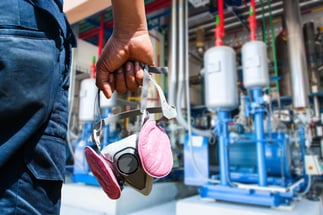
If you work in areas where you could possibly breathe in particulates, vapors or fibers, you probably already know that wearing respirators is crucial to your health and safety. You don’t want to breathe in harmful materials, so you wear your mask. But did you know that regular fit testing is the only way to know you are protected?
When was the last time you were properly fitted for your respirator?
OSHA uses information from sources like NIOSH to determine safe levels of particulate that can be inhaled in hazardous conditions such as air mixed with dusts, fibers, vapors, fumes and chemical or biological hazards. Fit testing is used to figure out the type of respirator a worker may need and what level of protection the mask will offer.
What is Qualitative Testing?
Qualitative fit testing is a pass/fail test that uses your sense of taste or smell, or your reaction to an irritant in order to detect leakage into the respirator facepiece. It doesn't measure the levels of leakage, but instead provides you with an indication of whether your mask is in good working condition or if there are any holes or gaps in the seal. OSHA allows for four different qualitative fit test methods for respirator safety:
- Isoamyl Acetate: has a banana-like smell.
- Saccharin: leaves a sweet taste in your mouth
- Bitrex: leaves a bitter taste in mouth.
- Irritant Smoke: causes coughing.
What is Quantitative Testing?
This method of fit testing uses a machine that is attached to any tight fitting respirator and doesn't rely upon your senses or reaction to irritants. Three different quantitative fit test methods are approved by OSHA:
- Generated Aerosol– an aerosol is dispensed into a booth or test chamber and any leaks into respirator are measured.
- Ambient Aerosol– uses laser technology to measure aerosol concentrations inside and outside of a mask without having to use a test chamber.
- Controlled Negative Pressure– a fixed vacuum is created on the facepiece with special adapters that then measure air flow or leak rate.
What Kind of Respirator Do you Need?
Whether or not you need a full face respirator or a half mask respirator depends on the APF or Assigned Protection Factor. APF is number used to describe the level of protection that a respirator can be expected to provide if it is used properly. While other organizations have different standards for respirators, APF supersedes all other standards and is the benchmark that employers must comply with.
Here are some great products to choose from:
- 3M™ Half Facepiece 7500 Series, Ultimate Reusable– Made from durable silcone, this facepiece features a soft sealing surface and can be interchanged with any of the 3M™ filters and cartridges, Series 2000, 5000, 6000 and 7093C.
- 3M™ Full Facepiece Respirator 6000 Series, Reusable– Made from a thermoplastic elastomer with a silicone faceseal, this comfortable and lightweight respirator features a large, hard-coated lens offering the user an unobstructed view. The low-maintenance design reduces the need for costly repair and is easy to clean.
- Bitrex™ Fit Test Kit– This test kit offers qualitative OSHA-compliant fit testing for disposable and reusable dust and mist respirators. Safer than saccharin, this test kit comes with disposable glass ampules designed to make pouring solution into nebulizers easier, reducing contamination.
Fit Test Basics
Employers are required to provide suitable respirators that comply with the guidelines that APF sets forth pertaining to hazardous jobs. Employers are required by law to perform PPE training and respirator fit tests on employees at least every 12 months. Proper respirator fitting and maintenance is the only way to protect workers from inhaling dangerous substances that have the potential to cause serious illness, or even death.
There are numerous reasons that could diminish the effectiveness and fit of a respirator:
- Weight gain or loss.
- Dental work or facial surgery.
- Significant scarring in areas that seal meets skin.
- Facial hair (beard, goatee, mustache)
- Glasses or protective eyewear.
Now that you know more about the importance of respirator fit tests and how important it is to be properly fitted on a regular basis, make sure to follow the recommended guidelines of respirator use. And don't forget regular maintenance! Remember to be fitted for respirators at least one time per year and for every new respirator you use, even if they are the same or similar make and model of the previous one. It might seem easier to just keep using the same old brand and the same old style that you're used to but remember, easy does not mean effective!
Safety: It's Your Life, It's Our Business.








